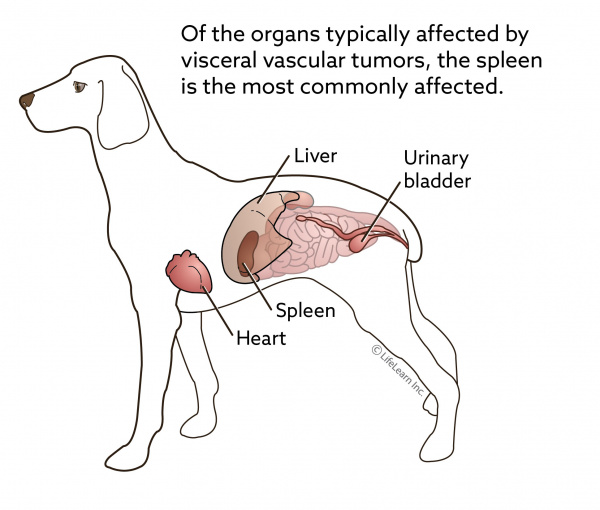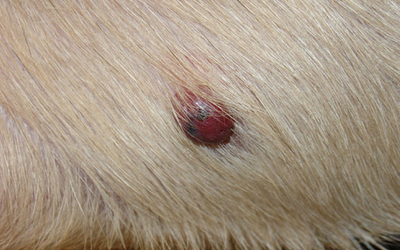Visceral Vascular Tumors
What are visceral vascular tumors?
Visceral vascular tumors are tumors that develop from the blood vessels found in the internal organs of the body, most commonly the heart, liver, and spleen, although other locations, such as the urinary bladder, are possible. The spleen, which is a blood- filtering organ, is the most common organ affected with these tumors. Essentially, wherever there are blood vessels, there is the chance for vascular tumors to develop.
There are two forms of visceral vascular tumors: hemangiomas and hemangiosarcomas. Hemangiomas are benign. They can be thought of as a large blood blister. Hemangiosarcomas are malignant and can spread to other parts of the body.

What causes this types of tumors?
The reason why a particular pet may develop these, or any tumor, is not straightforward. Very few tumors and cancers have a single known cause. Most seem to be caused by a complex mix of risk factors, some environmental and some genetic or hereditary.
While the cause of visceral vascular tumors in cats has not been determined, several genetic abnormalities have been identified in dogs. Certain breeds, such as German Shepherds, Labrador Retrievers, and Golden Retrievers, are particularly predisposed to developing hemangiosarcoma.
What are the clinical signs of these types of tumors?
The clinical signs vary depending on the location of the tumor. Tumors of the heart may cause signs of heart failure, including lethargy, weakness, collapse, coughing, or difficulty breathing; if the tumor ruptures, it can cause sudden death. Tumors of the liver and spleen can also rupture. Rupture can occur spontaneously, without any traumatic injury, and cause bleeding into the abdomen. Signs of internal bleeding include lethargy, weakness, collapse, decreased appetite, and a distended abdomen. If the bleeding is severe (and untreated), it can lead to death. Rupture of these tumors is a medical emergency.
How are this types of tumors diagnosed?
This type of tumor is often diagnosed with ultrasound of the chest or abdomen depending on the location of the tumor. Based on the findings, surgery may be recommended to remove the tumor, or in the case of a splenic tumor, remove the spleen. Samples of the tumor are then sent to a veterinary pathologist to evaluate the tissue under the microscope (called histopathology).
Up to 70% of dogs with splenic tumors have hemangiosarcoma. The rest (30%) may have a hemangioma or other type of tumor.
Staging (searching for potential spread to other locations in the body) should be pursued with any diagnosis of hemangiosarcoma. This could include bloodwork, checking the urine (urinalysis), checking your pet's ability to clot, X-rays, and an abdominal ultrasound. If any lymph nodes are found to be enlarged on physical examination, or with the above diagnostics, a sample may be obtained to look for spread of the cancer.

How do these types of tumors typically progress?
Hemangiomas are the benign form of the disease and have a good prognosis. Hemangiomas can rupture, however, and cause internal bleeding with the signs described above, but they are not known to spread.
Hemangiosarcoma, on the other hand, has a guarded to poor prognosis. As well as the risk of sudden bleeding, and death, hemangiosarcomas often spread to other parts of the body (metastasis), affecting other organs and risking bleeding in those areas. Metastasis to any organ can occur, including the lungs, kidneys, muscle, spinal cord, and brain. Growth of a tumor in these organs may cause signs specific to the organ affected (e.g., increased drinking with reduced kidney function if spread to the kidneys occurs).
What are the treatments for these types of tumors?
Surgery is the recommended treatment option. For both hemangiomas and hemangiosarcomas, surgery will prevent complications due to a rupture. Surgical options may be limited, however, with tumors of the heart. For tumors of the spleen, specifically hemangiosarcoma, a splenectomy (surgical removal of the spleen) is recommended. This will remove as much of the disease as possible and prevent the risk of further bleeding.
Given the highly metastatic nature of hemangiosarcoma, chemotherapy is also recommended. Chemotherapy can be used as a sole therapy when surgery is not possible.
Is there anything else I should know?
If you pet has been diagnosed with a tumor of the spleen, the biggest risk is that the tumor could rupture and bleed, putting your pet at immediate risk. Therefore, it is very important that your pet be kept quiet and monitored for any of the signs of bleeding listed above. Typically, once a diagnosis has been made, it is best not to wait to pursue therapy.
Anticoagulant medications or medications that may increase the risk of bleeding (such as nonsteroidal anti-inflammatories) should be avoided prior to surgery.



